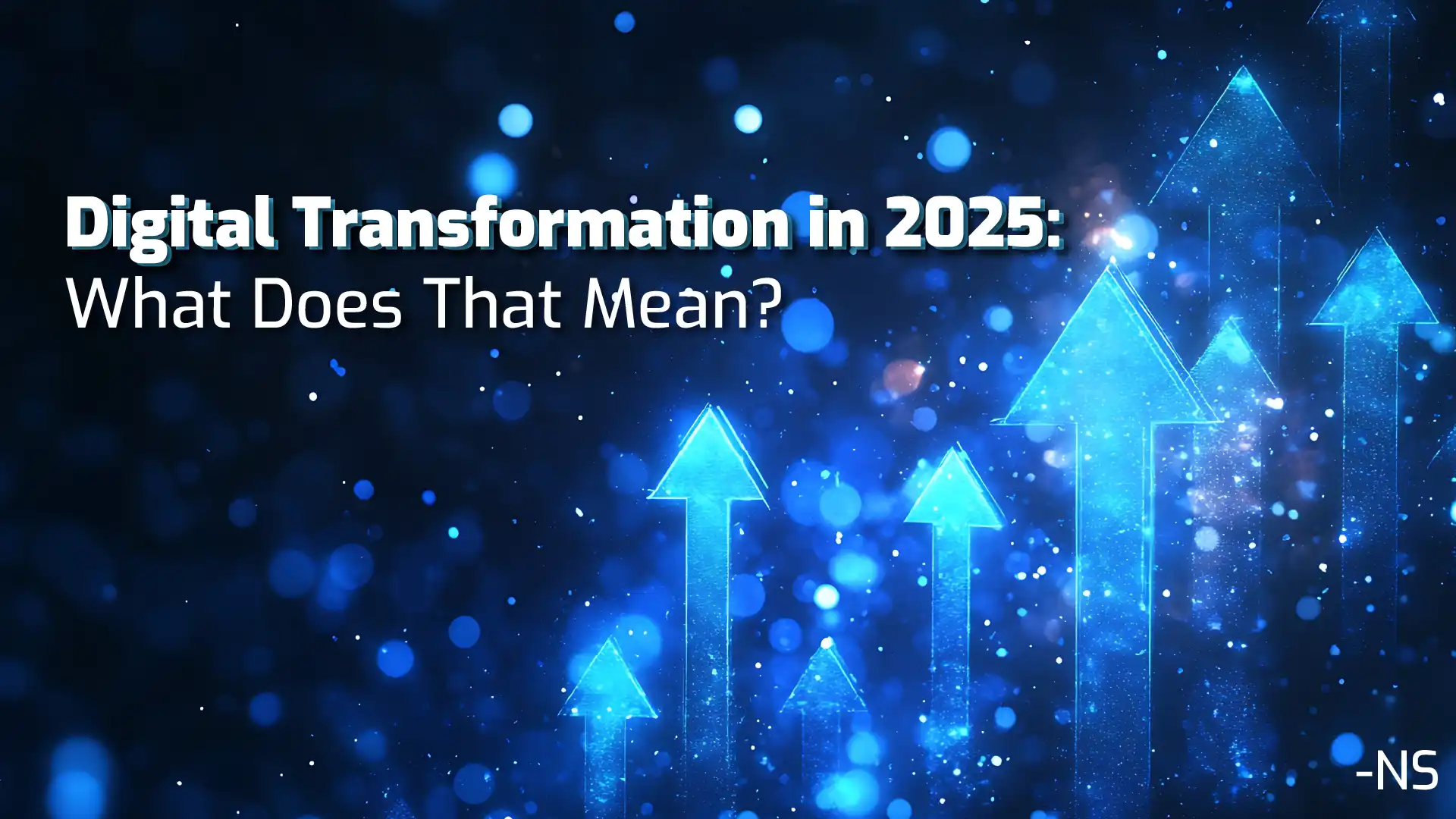It’s 2025: what does “digital transformation” mean to you?
Once it meant moving from paper to online or automating physical processes into virtual ones. Using the power and accuracy of computing solutions to improve (not just change) business.
Today when I look at digital transformation trends, I see it being a truly enormous bucket, covering everything from reorganizations to cloud migrations to remote work support to data management.
This makes it sometimes hard to grasp, practically, what the goal is. In the COVID world, it was everywhere, by necessity—everything from learning to shopping to work had to go through some kind of digital transformation.
Now this change includes AI.
McKinsey estimates that 90% of all organizations are currently undergoing some kind of digital transformation. Or almost all of us. Almost all the time. Some 40% of all IT spend is earmarked for automation in digital transformation initiatives.
Today I want to look at some examples of this transformation process as it stands in 2025, considering what it means to me, and what, in my opinion, the bullseye should be as we look into this fast-moving future.
If we’re always undergoing digital transformation, what is its goal, and how do we know if we’re hitting it?
Digital Transformation Circa 2025
With such vast coverage and so much variation in the definition, you’d expect to get varying stats on how much companies are actually spending.
Regardless of your definition, it’s probably in the trillions, globally (IDC puts it at $4 trillion by 2027).
And while any of these projects may not have involved AI originally (cloud integrations, SaaS solutions, IoT, blockchain, CRM, ERP), it’s increasingly synonymous with the concept.
You may be hard-pressed to find digital transformations wholly apart from AI today.
AI in Digital Transformation
Let’s look at some specific examples. I’m involved in my own, of course, both in-house at PTP and in my work with clients, but I want to start here with an example use case from the Harvard Business Review.
I love this example, as it deals with all the kinds of real-world wrinkles that make these transformations so complex (and ongoing). And it’s this complexity that can make them hard to realize, and especially to measure and fully evaluate.
In short, this example profiles the effort of a large healthcare insurance company seeking to use digital transformation to improve processing claims as the first step towards reimbursement. This is an enormous industry and can be, for anyone who’s been around it, an onerous, physical chore. It’s like a textbook case for the difficulties of wrangling unstructured data.
For me, this is the very heart of what digital transformation is (supposed to be) all about: improving or alleviating the work that is ill-suited for human beings, because it’s mind-numbing, with the constant repetition of process, frustrating variation in source, and need for complete accuracy.
And yet, for a number of real-world reasons, forms like these cannot all be provided digitally. Because of the regulation of personal information, the process cannot be offshored, and because of unique state regulations, the forms themselves cannot be fully standardized. The error rate in this case was exceedingly high (at some 90% of cases) because of handwriting interpretation and imperfect scanning.
When we think of all the fabulous things AI can do for us—generating movies, music, games from scratch, piloting vehicles, developing new proteins—it’s this use case, taking drudgery out of the hands of people and providing both security and a high level of accuracy, that may be the secret to AI having lasting business impact.
In this case, the complexity of the transition and its costs were both higher than expected, and the most important factor, according to the authors, was trial and error.
Machine learning models failed because of the broad language demands, and among pre-trained, generative AI solutions, they found the most effective ones were cost prohibitive at scale.
From ChatGPT to Claude (through AWS), scaling with ready AI (handling thousands of documents in the way needed) proved to be exceedingly expensive, and so they had to get creative.
In a process that’s increasingly becoming the core aim for agentic AI solutions, this team implemented a multi-tiered solution:
- Start by scanning all text for key words (using cheaper logic tool).
- Those failing this are sent to generative AI solution next (the more expensive tool employed only for edge cases).
- And while only 2.7% of these still had errors needing human checkers (vs. 90% before), 27% needed human verification because of AI uncertainty.
In my own work I routinely find that AI does not eliminate staffing at the level some may expect, but it does allow for a shifting of resources, and a capacity to significantly scale up, both in volume and, in the right circumstances, quality.
The same was found here.
While staffing reduction didn’t meet expectations (they still needed around the same headcount, though shifted), productivity through AI increased three-fold, with only 10% of the average time needed per document as before.
I’ve seen similar results with automation solutions, be it with workflow improvements, customer service, recruiting, sales, or medicine. More work is done more efficiently, and through this measure, with a reduction of cost-per that can be exponential.
And for the workforce, freed from the worst kind of data entry, focus shifts to more mentally intensive, varied work.
The Role for AI Agents in Business
The true goal of digital transformation is increased quality and cost-effectiveness, and that result here was attained. While expenses were higher than expected, they reached their breakeven point in 10 months.
More importantly, their original solution was untenable. Since the COVID surge, they failed to manage the demand, and this new solution does that and more. While costs are up, their scale is tripled, as they process a higher volume with fewer errors.
While it was not as simple as routing through a ready tool, a multi-stage process enabled a cost-effective solution that solved their pain.
Getting to this multi-stage process without all the same trial and error is the goal of AI agents.
We are now seeing systems that can internalize much of this process themselves. With the ability to apply reasoning steps and use APIs and multiple models, these systems will increasingly provide more of what’s needed in cases like this, measuring the cost and quality of variable solutions, allowing businesses to bring together various-step solutions more easily.
As the head of a tech recruiting and consulting firm, I am seeing first-hand how agentic solutions are enabling digital transformation processes like the one profiled above, integrating with existing systems, parsing data for patterns, handling back-and-forth communication and decision-making, and then looking to human experts or managers for sign-off approval and quality control.
Business Transformation Tips
The process outlined above was both exploratory and successful, but as we move into 2025, there’s a growing sense of impatience, I believe, for AI experimentation at scale.
Deloitte found that more than two-thirds of businesses polled in their State of Generative AI in the Enterprise report had moved few (30% or less) of their AI experiments into production in 2024.
This means ongoing experiments, uncertain returns, and unsuccessful initiatives.
Digital transformation is at the core of what we do at Peterson Technology Partners, and as we move into 2025, I believe the following will be essential touchstones for businesses:
- Clarity is key. This isn’t new, but AI, with all its hype, pace of change, and difficult-to-parse expenses may require this more than ever. Tech leadership in digital transformation requires a clear vision with measurable metrics aligned to achievable business objectives. This should include a willingness to embrace fast failure. (But I believe the too-broad application of terms like “digital transformation” is part of the problem here, as it can limit clarity.)
- Talent is timeless. It may be fashionable to say that AI isn’t going to radically reduce jobs, but I’m also seeing that it’s true. Workforces are being shifted, but human skills are as necessary as ever. But don’t take my word for it: the World Economic Forum (WEF)’s Future of Jobs Report 2025 predicts 170 million jobs created globally by 2030, with 92 million removed, resulting in a net gain of 78 million. (It also found 77% of organizations working on retraining programs, alongside 70% actively hiring AI specialists.)
- Embrace data governance. Data is the food AI needs to live, the fuel for the engine, the foundation it’s built from. To use it effectively at scale, you must be able to know what is going in and what is coming out, and you need clean, well-governed data. We recently released a PTP Report on this topic—take a look for more here.
- Change management is critical. Digital transformation is no longer (if ever) finite, but more often than not a continuous initiative. This means effective measurement (which with AI processes is still quite tricky), strong and open communication, careful planning with allowance for trial and error, phased rollouts, and as much transparency as possible.
The expectation for AI-backed digital transformation projects is to face workforce resistance, and in my experience, there is definitely a lot of anxiety.
But by taking drudgery off the table for workers, I have been surprised at the level of employee involvement in AI transformations. You will need subject matter as well as AI experts, and this is another area where PTP can help out.
Conclusion
I opened by asking what digital transformation means today.
Ultimately, I believe it’s this: it’s about being more efficient overall, more cost-effective, and with higher quality. It will often not go according to plan, but in the end, it is a commitment to continuous improvement that is essential in today’s world.
Generative AI solutions, with their frustratingly obscure, though wonderful, capacities, do not yet make this easier, even if the change, in the end, can be more powerful.
And to me, digital transformation in 2025, perhaps more than ever before, is about getting people to higher value work.
References
What is digital transformation?, McKinsey & Company
How One Company Used AI to Manage the Deluge of Documents, Harvard Business Review
The Future of Jobs Report 2025, World Economic Forum





